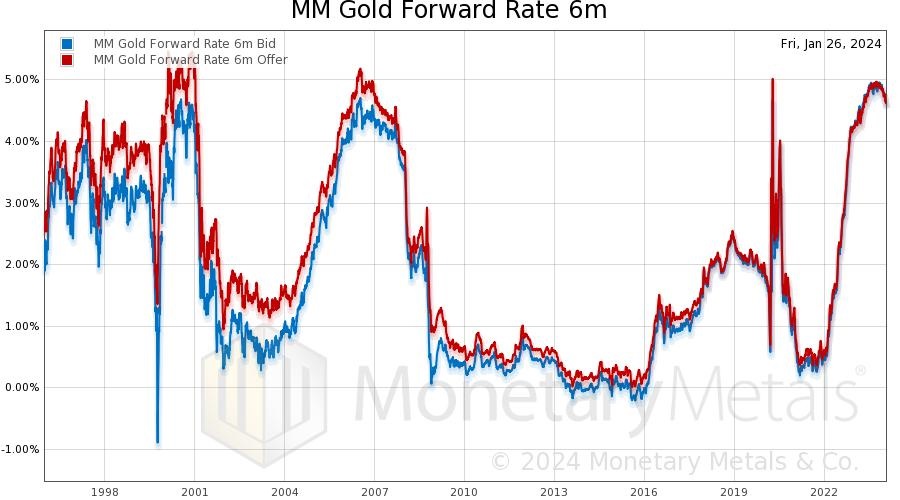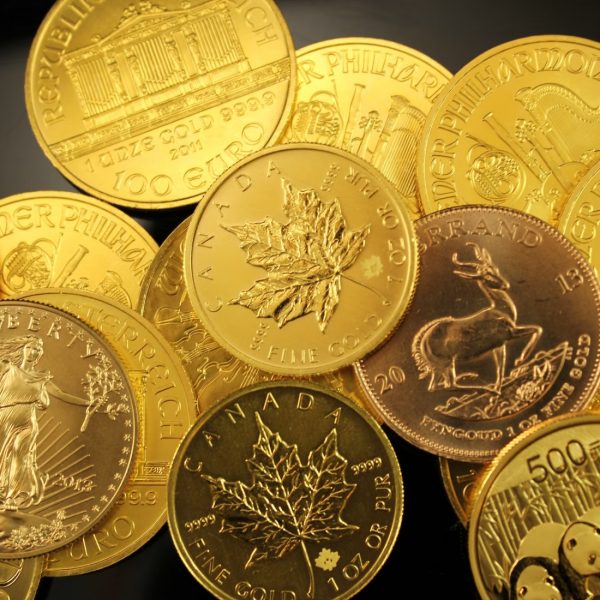Understanding GOFO: A Simplified Guide to Gold Forward Rates
30/01/2024Daniel Fisher
Free & fully insured UK Delivery. Learn more
Secure & flexible payments. Learn more

Buyback Guarantee Learn more

While gold itself is a straightforward concept, some of the jargon around the subject can be confusing and complicated. One such term frequently quoted when analysing the gold price from a technical perspective is the GOFO.
This acronym stands for the Gold Forward Offered Rate, which in essence is the percentage rate charged to borrow US Dollars, if simultaneously swapped with gold as collateral.
The Gold Forward Offered Rate, or GOFO, represents the interest rate at which participants in the gold market are willing to lend gold on a swap against US Dollars. On the flip side of the equation, it’s the interest rate on a Dollar loan if you’re able to back the borrowing with gold as collateral.
The rate provides a current snapshot of the dynamic between the gold and Dollar borrowing and lending markets. Specifically, the swap reflects the relationship between the US Dollar interest rate (LIBOR) and the Gold Lease Rate (GLR).
To truly comprehend GOFO, we need a glimpse into its historical development. GOFO emerged as a response to the growing demand for gold lending in the financial sector. Over time, it has evolved as a crucial benchmark, reflecting the changing dynamics of the gold market.
While traditionally the world’s central banks have held a vast majority of their reserves in Dollars since the end of the gold standard in 1971, the accelerating depreciation of the greenback has encouraged the evolution into holding more assets in gold bullion.
GOFO represents the cost of converting some of that gold into US Dollars when central banks need to settle debts.
While both GOFO and LIBOR involve interest rates, they serve different purposes. LIBOR, or the London Interbank Offered Rate, is a benchmark interest rate at which major global banks lend to one another in various currencies. On the other hand, GOFO focuses specifically on gold, representing the rate at which gold is lent in the market. However, the US Dollar LIBOR rate plays a crucial role in determining the GOFO as you’ll see from the calculation formula lower down.
The two benchmarks have their differences, but together their respective rates indicate the availability of gold vs cash currency financing.
With GOFO representing a swap between gold and US Dollars, it’s important to understand the basics of forward rates as a financial swap is essentially a series of forward contracts. A forward rate, in simple terms, is the agreed-upon interest rate between two parties for a financial transaction to occur at a future date. In the context of gold, GOFO is essentially the forward rate for lending or borrowing gold. It sets the stage for understanding the cost of obtaining gold or lending it over a specified period. These rates therefore provide a window into the market’s expectations of the relationship between gold and Dollar borrowing and values over a set future period.

Clearly there are various dynamics which influence the GOFO. The gold market, like any other, is subject to the forces of supply and demand. When demand for gold is high, and the supply is limited, GOFO tends to rise. Conversely, when demand is low or there’s an abundance of available gold, GOFO may decrease.
The Dollar’s role in the equation means that interest rates and inflation also play a pivotal role. If interest rates rise, the cost of borrowing gold may increase, impacting GOFO. Similarly, inflation can erode the value of currency, influencing the attractiveness of gold lending.
The calculation of GOFO may seem daunting at first, but it boils down to the relationship between gold lease rates and LIBOR. Gold lease rates represent the cost of borrowing gold, while LIBOR serves as a benchmark for U.S. dollar interest rates.
providing a numerical representation of the cost of borrowing gold in the broader financial context.
GOFO is calculated by deducting the current gold lease rate (GLR) from LIBOR. It’s the difference between the cost of borrowing Dollars and gold, providing a numerical representation of the cost of borrowing gold in the broader financial context.
GOFO = LIBOR – GLR
This figure, stated as a percentage is usually in positive territory, meaning the price to buy gold for a future date is higher than the cost of buying gold now (spot price), a dynamic known as contango. On less frequent occasions, the Gold Forward Offered Rate may be a negative number, representing backwardation in the gold market.

6 month Gold Forward Rates over the past 25 years
The Gold Lease Rate (GLR) is the interest rate charged to borrow gold and is a fundamental component in understanding the dynamics of the gold lending market. Interestingly, this lending process also suggest that, contrary to popular definition, gold can actually offer a yield, or income. It represents the cost associated with leasing gold, creating opportunities for trading gold in the form of ETFs (Exchange-Traded Funds).
Gold leasing involves large bullion banks and dealers lending their gold holdings to other institutions in exchange for interest income. The borrower pays an agreed gold lease rate (GLR), in much the same way to the interest rate in currency lending markets.
These gold financing arrangements generate liquidity for bullion owners to redeploy for investment or other income opportunities, while borrowers can utilize the gold over the lease term.
The GLR plays a crucial role in facilitating gold leasing arrangements, functioning much like the lending and borrowing of currencies in other financial markets. As these transactions unfold, they contribute to the overall liquidity and dynamics of the gold market, with the gold lease rate serving as a key metric in this intricate process.

Understanding the significance of GOFO involves recognizing its integral role in gold lease rates. Gold lease rates represent the cost associated with borrowing gold, and GOFO, being a key component in their calculation, directly influences these rates.
The formula for the Gold Lease Rate was historically calculated by;
GLR = LIBOR – GOFO
However, with the GOFO no longer publicly quoted by the London Bullion Market Association (LBMA), the GLR is derived through other means.
When GOFO rates are high, it indicates that the demand for gold in the lending market is robust, potentially signalling increased interest in leveraging gold assets. Conversely, lower GOFO rates may suggest a more relaxed environment for gold borrowing.
For investors, GOFO serves as a valuable indicator with direct implications for their strategies. When GOFO rates are on the rise, it may signal a potential uptick in demand for gold, reflecting a broader trend in the market. This information can be particularly relevant for those involved in precious metals investments deciding the best time to buy gold.
Conversely, declining GOFO rates may indicate a shift in market sentiment, potentially impacting the attractiveness of gold as a lending asset. Investors keen on navigating the volatile terrain of precious metals can use GOFO as a tool to gauge market trends and make informed decisions.
Free ultimate guide for keen precious metals investors
The LBMA plays a central role in the world of precious metals, including its involvement in the GOFO process. As a global authority on precious metals markets, the LBMA is a key player in establishing standards and practices for the industry.
Historically, the LBMA used to publish the daily GOFO rates for the following lending periods; 1-month, 2-month, 3-month, 6-month, 1-year. LBMA’s recording and sharing of Gold Forward Rates started in 1989 and halted on 30th January 2015.
Specifically in the context of GOFO, the LBMA now provides oversight and ensures the integrity of the process. It sets the stage for market participants by establishing guidelines and best practices. The LBMA’s involvement adds a layer of credibility to the GOFO rates, contributing to the overall stability and trustworthiness of the gold lending market.
The GOFO rates are no longer publicly shared by the LBMA and are instead quoted privately in specific marketplaces where gold lending transactions occur. These marketplaces, often interdealer broker systems, serve as platforms for participants to negotiate and finalize gold lending arrangements.
Arguably, the transition from the LBMA’s daily publishing to a more private affair has diluted the universal use of GOFO as a market indicator. But professional participants still keep a close eye on these quotes to make informed decisions based on prevailing market conditions.
The relevance of GOFO extends beyond the confines of the gold market; it serves as a valuable economic indicator. When viewed through the lens of economic conditions, GOFO can provide a dynamic insight into the broader financial landscape.
Rising GOFO rates may suggest increased demand for gold in lending transactions, potentially indicating concerns about economic stability. Conversely, declining GOFO rates might signal a more relaxed environment, potentially reflecting confidence in economic conditions. Understanding GOFO’s implications enables analysts and investors to interpret market sentiment, helping participants with investment decisions and strategy.

The relationship between GOFO and central bank policies adds another layer to its significance. Central banks, as key players in economic regulation, can influence GOFO through their monetary policies. And don’t forget, these are the same central banks who hold vast gold bullion reserves, which can be lent if fiat money needs to be raised.
If a central bank lowers interest rates to encourage borrowing, investment, and stimulate economic growth, it may impact GOFO rates. The relationship is intricate; GOFO can act as a barometer for the effectiveness of these policies in stimulating economic activity. Monitoring this relationship provides a unique vantage point to predict possible upcoming changes to monetary policy.
While GOFO is a valuable tool, it’s not without its sceptics. Critics argue that it may not always provide a fool-proof gauge of market sentiment. One common criticism revolves around the limited scope of the gold market that GOFO represents. Some argue that its sensitivity to changes in demand and supply may not capture the broader economic landscape accurately. It can be heavily influenced by short-term scarcity of gold supply amongst gold lending participants.
Additionally, GOFO’s dependence on interest rates and inflation can be seen as a limitation. In rapidly changing economic conditions, GOFO may not respond as swiftly as some analysts would prefer, potentially leading to delayed signals or misinterpretations. This is becoming increasingly apparent in today’s progressively globalised and nuanced digital economy.
GOFO’s reliance on the interplay between gold lease rates and LIBOR also introduces limitations. Critics highlight that these rates may not always reflect the true cost of borrowing or lending in the gold market. External factors, such as geopolitical events or sudden market shocks, can disrupt the expected correlation between these rates, undermining the reliability of GOFO as a predictive tool.
Much like any commonly used economic indicators, GOFO should be referred to along with other gauges to determine a more rounded view of economic conditions. Any one indicator on its own will always be prone to limitations.
If you need help with your gold investment, our expert team can provide as much or as little guidance as you need. Give us a call to discuss your objectives on 020 7060 9992 and we can recommend the best gold products to achieve your goals.


GOFO, or Gold Forward Offered Rate, is the interest rate at which participants in the gold market lend or borrow gold. It matters because it provides insights into the cost of borrowing or lending gold, influencing economic conditions and serving as an indicator for market trends.
GOFO is calculated by subtracting the gold lease rate from the LIBOR rate. Factors like supply and demand for gold, as well as interest rates and inflation, influence GOFO. High demand for gold or rising interest rates can cause GOFO rates to increase.
GOFO is integral to the gold leasing market, influencing the cost of borrowing or lending gold. It serves as a key component in determining gold lease rates, which are crucial for large companies, often bullion banks, engaging in gold leasing transactions to raise dollars for liquidity.
GOFO acts as an economic indicator by reflecting changes in market sentiment. Rising GOFO rates may indicate increased demand for gold lending, potentially signalling economic concerns. Conversely, declining GOFO rates may suggest confidence in economic conditions.
The LBMA, or London Bullion Market Association, plays a central role in establishing standards for the precious metals market, including GOFO. It no longer publishes rates, but instead provides oversight, sets guidelines, and ensures the integrity of the GOFO process.
Image: Monetary Metals
Live Gold Spot Price in Sterling. Gold is one of the densest of all metals. It is a good conductor of heat and electricity. It is also soft and the most malleable and ductile of the elements; an ounce (31.1 grams; gold is weighed in troy ounces) can be beaten out to 187 square feet (about 17 square metres) in extremely thin sheets called gold leaf.
Live Silver Spot Price in Sterling. Silver (Ag), chemical element, a white lustrous metal valued for its decorative beauty and electrical conductivity. Silver is located in Group 11 (Ib) and Period 5 of the periodic table, between copper (Period 4) and gold (Period 6), and its physical and chemical properties are intermediate between those two metals.